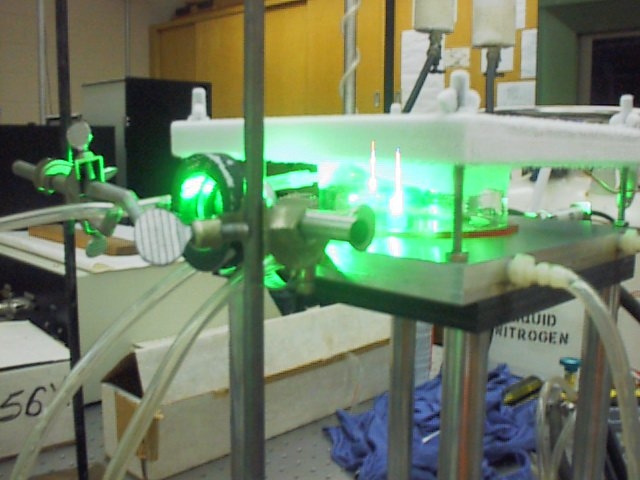Homebuilt LVCC Chamber

Nanostructured Materials
Nanoscale particles possess several unique properties such as large
surface areas, unusual adsorptive properties, surface defects and fast
diffusivities. The intrinsic properties of the interior of the
nanocrystals are transformed by quantum size effects. The ability to
manipulate the energetics of nanocrystal surfaces at will would have
many practical consequences particularly in the fields of catalysis and
novel materials.
Laser Vaporization Controlled Condensation
Recently, we have developed a new method for generating nanoscale metal
oxide, nitride or carbide particles down to 5 nm size by laser
vaporization of metal targets followed by gas phase reactions and
deposition onto cold surfaces in a diffusion cloud chamber. Particle
size is readily controlled by the degree of supersaturation, which is
controlled through the temperature gradient, pressure and laser power.
The composition is controlled by the choice of the solid target and the
gas mixture.
Nanowires
Controlled synthesis of 1-D structures has generated significant interest in the scientific community. Literature has shown that crystalline wires can be synthesized using vapor-liquid-solid (VLS) growth mechanism.
We have synthesized nanowires via laser vaporization in a furnace where choice of laser power, pressure, flow rate and composition of the target control the diameter and length of the resulting wires. According to the vapor-liquid-solid (VLS) phase diagram, wire formation is possible when sufficient heat is applied ensuring the proper catalyst is in the liquid phase. Interactions between the catalyst and evaporated materials ultimately lead to precipitation occurring in one direction.
Maintained by: Garry Glaspell |
©2005 El-Shall Research Group
Last Modified On 07/25/05
This page does not reflect an official position of Virginia Commonwealth University
